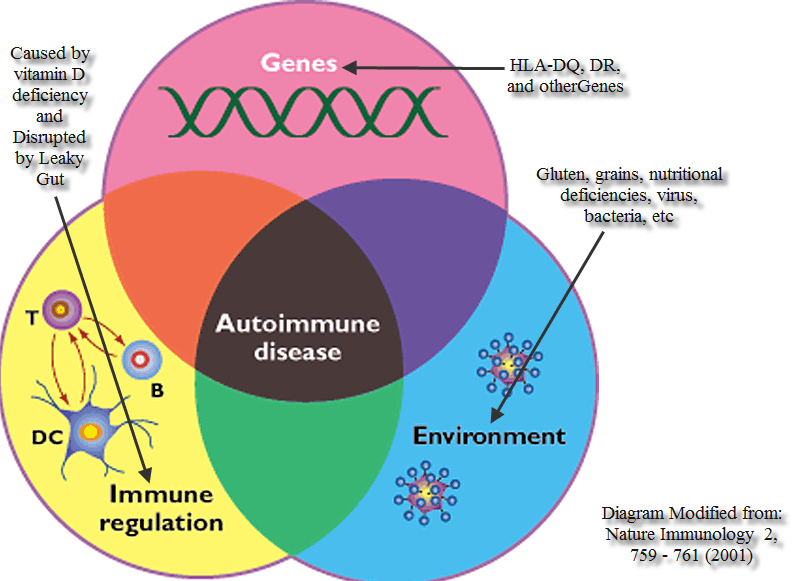We’re hearing a whole lot about autoimmune conditions these days, and for good reason: autoimmune disease affects over 80 million people, and there’s been a sharp rise in autoimmune disorders. In comparison, cancer affects up to 9 million and heart disease up to 22 million. There are over 80 (some sources say 100) known autoimmune diseases; they are chronic and last a lifetime; and your chance of being diagnosed is one in 13.
Most Common Autoimmune Diseases
- Graves’ disease
- Hashimoto’s thyroiditis
- Systemic lupus erythematosus (lupus)
- Type 1 diabetes
- Multiple sclerosis (MS)
- Rheumatoid arthritis
- Psoriasis & eczema
- Celiac disease
What is Autoimmune Disease?
Autoimmune disease is a case of mistaken identity. In response to some kind of trigger, the immune system starts overreacting and misfiring, producing antibodies that attack the body’s own tissues instead of foreign invaders. This causes ongoing inflammation. Organs and tissue (such as the thyroid gland) can be damaged as a result.
People often suffer autoimmune “flare-ups” when an inflammatory trigger causes severe symptoms to surface for a period of time. I see this most often in my Celiac clients who accidentally eat gluten, causing them severe digestive pain for days. Emotional trauma and stress may also cause a flare.
Scientists theorize the origins of autoimmune conditions are in the digestive tract. A recent study linked autoimmune reactions to a bacteria in the gut called Enterococcus gallinarum. An autoimmune response, can be triggered when the bacterium spontaneously migrates from the gut to other organs in the body, such as the spleen, liver, and lymph nodes. (source)
Other bacteria, such as Klebsiella, and viruses such as Epstein-Barr can trigger autoimmune disease.
Conventional treatment for autoimmune diseases generally focuses on reducing immune system activity with immunosuppressive drugs. While these medications can be effective at reducing some of the symptoms of the condition, because they suppress the entire immune system, they aren’t without many unwanted side effects: fatigue, weight gain, depression, increased infection rates and even cancer, and obviously they do not address the underlying cause.
Risk Factors for Autoimmune Disease
There are several key factors that have to be present in order to develop autoimmune disease. Certainly there is a genetic component, but triggers must occur in order to for the disease to express itself. Often this can be exposure to toxins or physical trauma or a traumatic event that’s a major stressor on the body. But just because you have a history of autoimmune disease in your family does not mean you will develop it. You can overwrite your genetic code and prevent the disease via diet and lifestyle (epigenetics).
One of more of the following must be present for autoimmune disease to surface:
- history of autoimmune disease in your family
- toxins (from heavy metals, mold in your environment, etc)
- GI infections such as candida and/or pathogenic bacteria like H pylori, klebsiella, enterococcus gallinarum
- Viruses such as Epstein-Barr, herpes, and/or mononucleosis
- Food intolerances: There is a specific link between autoimmune disease and gluten intolerance.
- Leaky gut syndrome, which causes an overactive immune response
The devastating issue I see with my clients is that they’ve been shuffled around to specialists and doctors for years before their autoimmune condition is even diagnosed. A rise in specific antibodies has to be detected via blood testing in order for a proper diagnosis to be made, so it doesn’t show up on regular bloodwork (though patterns can be spotted that should clue your physician into requesting further testing for a diagnosis). Then patients are given anti-inflammatory or immunosuppressive drugs and told their condition is not curable (true) or reversible (not true).
Though symptoms vary widely, here are a few signs of autoimmune disease:
- Joint pain, muscle pain or weakness or a tremor
- Weight loss, insomnia, heat intolerance or rapid heartbeat
- Recurrent rashes or hives, sun-sensitivity, a butterfly-shaped rash across your nose and cheeks.
- Difficulty concentrating or focusing
- Feeling tired or fatigued, weight gain or cold intolerance
- Hair loss or white patches on your skin or inside your mouth
- Abdominal pain, blood or mucus in your stool, diarrhea or mouth ulcers
- Dry eyes, mouth or skin
- Numbness or tingling in the hands or feet
- Multiple miscarriages
8 Steps to Reversing Autoimmune Disease
If you’ve been diagnosed with an autoimmune condition, I have good news for you. It may be possible to put certain autoimmune conditions into remission and free yourself from symptoms and flares. I have seen it in colleagues and clients (mostly regarding autoimmune thyroid conditions): blood tests that reveal no presence of the high antibody levels that indicates autoimmune disease is present. The disease (in some cases) is reversible through changing your diet and lifestyle habits and balancing your immune system.
I should be clear, however, that there is no cure for autoimmune disease, but symptoms can be managed effectively in some cases so that antibodies fall into normal levels on lab work.
1. Give up the grains and lectins. Step 1 is changing your diet, and grains are the first to go. As we’ve discussed, gluten is strongly correlated with autoimmune disease, especially Hashimoto’s and Grave’s. Grains contain lectins that irritate the gut lining, contributing to inflammation, and the main goal in reducing autoimmune flares and reversing the disease is quelling inflammation in the gut and systemically. Nightshades may also be problematic, especially for rheumatoid. Additionally, if someone has a gluten intolerance, all grains should be avoided for a time due to molecular mimicry (a main issue with autoimmune disease): certain foods such as dairy, some grains, and yeast trigger an immune response because the body thinks you’re eating gluten.
2. Ditch the Dairy. Allergies or intolerances to casein are extremely common, and these intolerances contribute to the inflammation we’re attempting to combat. Plus, dairy can be a cross reactive food for the gluten intolerant. One caveat: if you are not sensitive to casein, raw dairy may actually boost immune health, but I have everyone eliminate it for 60 days initially. Read more on dairy here.
3. Determine your food intolerances. I put all my autoimmune clients on some form of an autoimmune paleo protocol for at least 30 days to see what improvements they make. This means eliminating grains, dairy, legumes, nuts/seeds, nightshades, eggs, alcohol. Once they start feeling better, we reintroduce foods one by one, slowly, to see which foods produce a reaction. Read the “whys” behind the autoimmune protocol here. Essentially we’re looking for foods that are triggering immune activity and contribute to leaky gut, an underlying cause of autoimmune disease. You want an anti-inflammatory diet that’s right for you. It will look different for each person depending upon to which foods you react. This article outlines how to reintroduce foods and where to go after the autoimmune protocol.
Before you panic about all the foods you have to give up: Don’t worry, you won’t have to be this strict forever. The autoimmune protocol isn’t designed for longterm compliance. It’s an allergy elimination diet to see which foods are causing you inflammation, so you know which foods to eliminate. Even if you react to multiple foods and have to steer clear of those for several months, you can try reintroducing them again a few months later. Healing leaky gut means many food intolerances heal. And you don’t want to be on a restrictive diet long term! I don’t recommend the full autoimmune diet longer than 90 days.
4. Normalize your vitamin D levels. Vitamin D is crucial for a healthy immune system. There is increasing epidemiologic evidence linking vitamin D deficiency and autoimmune diseases including multiple sclerosis, rheumatoid arthritis, type 1 diabetes, inflammatory bowel disease and systemic lupus (source). I recommend starting vitamin D supplementation right away. You can test your levels with a home test kit. Get it here (this link gets you a discount on the kit; just search for vitamin D kit).
5. Fix your gut. Though we aren’t sure about the origins of autoimmune disease, we do know it involves the digestive tract, because 60-80% of your immune system is in the gut. The theory is that multiple food allergies, poor gut flora, certain strains of “bad” bacteria, and leaky gut constantly keep the immune system firing and working until it finally begins misfiring. How to fix your gut? Fix leaky gut, eliminate allergenic foods and foods high in anti-nutrients (on the autoimmune protocol), and stool testing to determine if pathogenic bacterial infections, viral triggers, parasites, and/or candida are present. Certain strains of bacteria such as Yersinia and H pylori can trigger autoimmune conditions. Rebalance gut flora. I recommend the GI MAP stool test (<– order here, 7th down the menu) to get an accurate picture of your overall gut health + it tests for pathogens, parasites, yeast, and dysbiosis.
6. Relieve stress to prevent flares. Stress and trauma are often the straws that break the camel’s back. There is a clear connection between stress wearing down the gut, sending your hormones haywire, and increasing inflammation. I recommend meditation, detox baths, and read these tips to support yourself through the stress that is inevitable in every day life. Exercise also helps. SLEEP 8 hours for repair and recovery.
7. Find hidden infections. We know that autoimmune disease surfaces in those with reactivated viruses such as Epstein-Barr, herpes, or those who’ve had mono. Ask your doctor to test for underlying infections that can be addressed. These viruses continually affect your immune system. The GI MAP stool test has a section that checks for pathogens in your gut that are autoimmune triggers.
8. Reduce inflammation. Aside from curating your autoimmune anti-inflammatory diet and fixing your gut, reduce inflammation by including an omega-3 fatty acid supplement, curcumin, and managing cortisol levels. Also include glutathione, one of the body’s most potent antioxidants and detoxifiers.
Resources
Autoimmune Paleo information and recipes
The Autoimmune Solution
The Paleo Mom has some great info on autoimmune
Info on Hashimoto’s, autoimmune thyroiditis
The Wahls Protocol
Don’t forget to pin it!

Mary Vance is a Certified Nutrition Consultant and author specializing in digestive health. She combines a science-based approach with natural therapies to rebalance the body. In addition to her 1:1 coaching, she offers courses to help you heal your gut and improve your health. Mary lives in San Francisco and Lake Tahoe in Northern California. Read more about her coaching practice here and her background here.









Great article! As always, great content, Mary 🙂
thank you, stacey!
Thanks for sharing. Going to have to try this.
Hi Mary, would this work for me? I have had alopecia universalis for about a year. Let me know if you need more information as I would appreciate any help you can give me!
Always beneficial to try with any autoimmune condition.
Any suggestions for vitality?
Years ago, I was very ill having been very healthy, diagnosed with ulcerative colitis, needed immediate major operation, thankfully 30 years later I just get on with the obvious, thanks to my supportive wife and great family. Age 52 I was diagnosed with type 1 diabetes and 2 years later after many MRI scans confirmed RRMS, 2 episoded c8nfirmed MS with the scans, namely a numb right side of my face and double vision, ok at present. Now 55 I continue to be in good health, keep my blood sugar under control and struggle a bit with MS, I was really active, stillmwant to be but I am limited due to balance issues and while I cope with fatigue it is always there. Sorry for the long winded story, all the above appear linked to your article, is it feasible to reduce my MS medication and possible insulin reliance, doctors here tend to specialise on one area and do not linknto autoimmune?
I would encourage you to read “The Autoimmune Solution” linked in the article and try the diet and lifestyle modifications I mention, working with your doctor.
Just want to say thank you Mary, this helps so much!
Great tips on reversing autoimmune diseases. I have had psoriasis now for about 3.5 years. For a long time it didn’t really bother me as it was on my lower back and could easily be covered up. But now I am starting to see a few more spots on my neck and stomach show up.
I have been dairy and mostly gluten free now for well over 12 months. I have also tried to give up eggs for 2 months which didn’t help either, so maybe now I will try nightshades, etc.
I am fairly certain that my vitamin D levels are adequate based on blood work. Are you ever concerned at all about taking too much vitamin D?
Thanks again for the great read!
Hi John, too much D is not good, but I’ve never seen levels too high. I don’t recommend taking it indefinitely. I typically have people take enough to bring their levels up, then take it during the winter to ensure levels stay up. You might also want to consider food allergy testing (link to test I recommend at end of post): https://www.maryvancenc.com/food-allergy-testing-helpful-or-hoax/
Have you had any experience with Autoimmune Hemolytic Anemia? I’ve put myself on the AIP protocol and I’m keeping my fingers crossed. I’m still on 10 mg of Prednisone and my hematologist is very cautiously lowering the dose. I dread my CBC tests, worried about the declining trend of my red count. My efforts have been the diet change, probiotics, and Glutamine.
People like you should be ashamed. Peddling your book to people suffering from disease that are not cureable or reversible. I could start with the fact that no one knows what triggers autoimmune diseases, or that they are ALL genetically linked. But I won’t waste my time. You’re the modern day version of a snake oil selling salesman. Let’s s see if you actually allow this comment on you’re page. Guessing you won’t.
I will not rule out that eating and less stress can help reduce the symptoms of some autoimmune diseases, but I take VERY high offense in your article insinuating that Type 1 diabetes can in any way be reversed. There is enough confusion and miseducation about Type 1 diabetes, please do not add to it.
Dawn Backs
45 years of T1D
4 years of RA
Stephanie, comments like yours amuse me. First off, not sure where you got the idea that I have a book about AI conditions? Clearly you didn’t read the article. I’m not “peddling” anything other than the information and knowledge people need to help themselves. I appreciate you stopping by to shit all over this post, but your feedback is incorrect. It is certainly possible to put certain autoimmune conditions into remission. Of course not 100 percent of the time, but making diet and lifestyle changes is always a positive. Do us all a favor and take your negativity elsewhere.
Not sure where you get that I am insinuating type I diabetes can be reversed? (though current research states it may be possible). I say that it is possible to reverse certain AI conditions. Type 1 diabetes is rarely reversed, but with the right dietary changes, major improvements in blood sugar levels can be seen and a person can often reduce his or her dependence on insulin and medications.
I beat rheumatoid arthritis with very similar guidelines. All natural with no drugs. And I had it pretty bad. I can say it’s I’m in remission now!
If anyone wants help you can email me
Fullyfruits@gmail.com
I am a 64 year old female, I was diagnosed of Multiple Sclerosis (MS) in 2008 (MRI), my symptoms started out with severe fatigue, poor balance, numbness, double vision, heat intolerance and anxiety. I was unable to go back to work, I tried Betaseron for about 6 years. Tried every shot available, all made me sick.
In November 2015, I started on Multiple Sclerosis (MS) Herbal formula from NewLife Clinic, the treatment worked incredibly for my MS condition. I used the NewLife MS Herbal formula for a total time period of 4 months, it totally reversed my Multiple Sclerosis. I had a total decline of all symptoms including vision problems, numbness and others. Sometimes, i totally forget i ever had MS.
Visit NewLife Clinic web-site ww w. newlifeherbalclinic. com. I am very pleased with this treatment. I eat well, sleep well and exercise regularly. My attitude is extremely positive.
Epstein Bar keeps kicking my butt and I believe it causes a flare up of my Hashimotos. Aip has helped the Hashi symptoms considerably but… Any suggestions on battling the Epstein Bar?
Hi Deborah, there are certain immune boosters (like monolaurin, medicinal mushrooms) that can modulate the immune system. Really best to work with a practitioner who can help you, as it gets complicated knowing how to balance the immune system: https://autoimmunewellness.com/how-do-you-balance-th1-and-th2-in-autoimmune-disease/
Also check out Datis Kharrazian’s book: https://www.amazon.com/gp/product/0985690402?ie=UTF8&tag=maryvancnutrc-20&camp=1789&linkCode=xm2&creativeASIN=0985690402
What are your thoughts on Ehlers Danlos Syndrome?
Jeff, I primarily work with Hashimoto’s and RA. I don’t work with Ehlers Danlos cases.
Hello,
Do you have any experience with Auto Immune Encephalitis? ?
Hi George, no, I only work with RA and Hashimoto’s.
Hi Mary, These are great suggestions. I had Auto Immune Disease. Had Lupus and have healed myself through starting with the elimination process. AI Protocol and making healthy lifestyle changes. IT CAN BE DONE. My doctor tried to put me on meds but I decided to go natural. Keep spreading the word girl. We are what we eat and our bodies are trying to tell us to pay attention.
Great tips for managing autoimmune disease. Finding the hidden infections is a tricky one sometimes. Finding a skilled DR to help you with the detective work is so key. Thx you for the great info!
I have had rheumatoid arthritis for 3 years now and I have found that vitamin D and low dose Naltrexone are the very best medicines to keep my pain controlled. If I try going off either one I have tremendous pain. Your comments and ideas are spot-on. I appreciate your article. I have cut way back on Grains and dairy as well. The vitamin D supplement surprised me the most however, I have been studying it quite a bit and it can do amazing things for your health. Vitamin D is actually a hormone that helps reduce inflammation throughout your body.
Mindi, yes! Vitamin D is so important for immune health. Glad you’re doing your research.
I tried vit d3 three times, I get so tired, sick, really feel out of it, as I am on diltiazem, calcium channel blocker, they do not mix
Stacey, yes, a good reminder to check with your doctor if you’re on RX meds before taking any supplements.
I have been dealing with extremely low Vit D levels ( 9 to 23) up and down for several years. I have taken prescribed Vit D (50,000 IU weekly + 1000 otc daily) and it has not gotten over 23. My last reading was in Nov 2018 and it was 19. Not long after that I was diagnosed with RA. my RA factor was 46 and a high ANA. In Jan. I started taking CBD Hemp oil 3 drops twice a day. Late Feb my Vit D level was 45.3. I was blown away. Turns out that Hemp/CBD is a great source of Vit D. So now am working to turn back the RA levels. I am taking Curamed that has helped tremendously with reducing swelling and inflammation. Still not where I want to be so any other suggestions you can share would be greatly appreciated.
Hi Mary, vitamin D must be taken with K2 for maximum absorption (and you must have adequate levels in your body to make and use D effectively). I use this one: https://maryvancenc.ehealthpro.com/products/vitamin-d-supreme-60-caps
and this for therapeutic dosages: https://maryvancenc.ehealthpro.com/products/vitamin-d-ultra-10k-60-caps
K2 is found most abundantly in fermented foods.
Besides juice diet for 4 months and probiotics, the best thing that helps me are DIGESTIVE ENZYMES . Got tired of diets. I have rheumatoid arthritis.
awesome information. I love your insights on this topic. More power to you
Hi I was diagnosed March 2017 but was running around from doctor to doctor before I finally get a result that I was free from MND ALS. Mine started on top and progressed into bottom I could walk very little but need assistance as I have no balance. It is sad all time that we thought this disease has no cure with all the technology we have while there re some formulas at there that can relief all symptoms and get this of ALS . I’m passing this info to anyone at there because totalcureherbsfoundation com has the right cure and caregiver this disease ….I took various supplements, medicine prescribed by neurologist,massage and physiotherapy still the disease is was progressing very fast until the the ALS formula from that company .
My first symptoms of ALS occurred in 2014, but was diagnosed in 2016. I had severe symptoms ranging from shortness of breath, balance problems, couldn’t walk without a walker or a power chair, i had difficulty swallowing and fatigue. I was given medications which helped but only for a short burst of time, then I decided to try alternative measures and began on ALS Formula treatment from Tree of Life Health clinic. It has made a tremendous difference for me (Visit w w w. treeoflifeherbalclinic .com ). I had improved walking balance, increased appetite, muscle strength, improved eyesight and others. ]
Hello Mary, I have just been diagnosed with Polymitosys. Do you recommend your Program for that disease? Thank you, Gene.
Hi gene, I’m not familiar with Polymitosys, but it looks like it’s an inflammatory condition (which is true of many AI conditions), and this diet is very useful for identifying foods that contribute to flares & inflammation. Make sure vitamin D levels are in the optimal range, and for pain and inflammation, anti-inflammatory herbs and supplements may be useful: https://www.maryvancenc.com/supplements-for-inflammation/